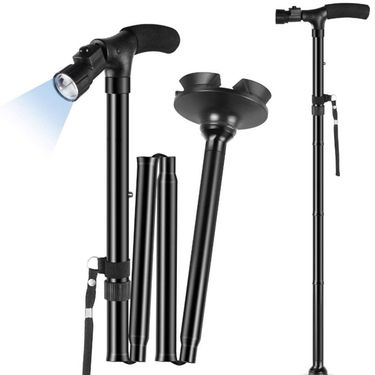Mobility Aids

LandTale Shower Caddy, Durable, 227 Kg, Tool-Free Assembly, Non-Slip, Stable, Adjustable Height, Narrow Bathtub, Shower,

24 hot DoublearmrestspowercrutcheswithalarmfortheelderlyTelescopicFoldableReedsStickLedWalkingTrueSticksStools

Stand Rail Mobility Aids Equipment Chair For Elderly Seniors Handicap Grab Bars Lift Supports Couch Cane Standing

Magic Cane folding walking stick for the elderly Aluminum alloy TV four-legged tumbler trekking stick LED with light

supregear Rail, Adjustable Stability Handrail Assist Bed Rail Mobility Aid Disabled With Storage Bag And Fixing Strap

Folding Cane with LED Light Foldable Walking Stick Anti-Slip Disability Aluminium Cane Torch Adjustable Portable Emergency Lamp

Collapsible Telescopic Folding Cane Elder Cane LED With alarm Walking Trusty Sticks Elder Crutches for Mothers the Elder Fathers

Aolawco Riser, Riser LED Sensor Light, Bed Entry Aid With Bag, Height Adjustable Grab Bar Handrails Seniors, For Elderly
Walker Mobility Aid: Gentle Support That Helps
There comes a moment for many older adults when walking doesn’t feel as effortless as it used to. Maybe the legs tire quickly, maybe balance feels unpredictable, or maybe recovery after an illness or surgery is still in progress. When this happens, the goal isn’t to limit movement—it’s to restore confidence. A walker mobility aid often becomes the first tool that helps seniors reclaim the small freedoms that shape a comfortable day.
And once we shift our focus from “walking farther” to “walking with confidence,” the choice of what kind of assistive devices to use becomes much clearer.
Starting with What Seniors Truly Worry About
Many seniors won’t admit they are afraid of falling, but you can see it in how carefully they move. Their first concern is usually stability: “Will this hold me if my knee gives out?” A good mobility aid responds to exactly that feeling.
But stability alone isn’t enough. If a walker is too heavy to lift over a doorstep or too stiff to turn around a dining chair, it becomes something people avoid rather than rely on. That’s why the best choices balance steadiness with ease of handling—lightweight frames, comfortable grips, and adjustable heights that match real daily routines.
Once those needs are acknowledged, seniors often begin to explore features that support longer outings.
When Resting Matters as Much as Walking
It’s common for older adults to enjoy gentle outdoor strolls but worry about fatigue halfway. This is where the comfort of a foldable walker with seat naturally fits in. Instead of planning trips around benches, a senior can rest whenever they need to—outside the pharmacy, in a quiet park corner, or even while waiting for a ride.
And because the walker folds easily, it doesn’t take over the home. It slides behind a door, fits into a car trunk during family visits, and stays manageable for caregivers. The freedom to walk knowing a rest is always available often becomes the turning point that encourages seniors to go outdoors more often.
Adding Gentle Wellness Habits That Support Better Mobility
As balance, joints, and stamina shift with age, walking comfort is influenced by more than just the mobility aid itself. Many families quietly build small routines around this—checking nutrition, encouraging light stretching, or managing stiffness after longer walks.
For example, maintaining daily micronutrients such as vitamins helps support muscles and bones, making each step feel steadier. Some seniors also enjoy using relaxation tools like massagers to ease tension in calves, back, or shoulders after movement. These aren’t dramatic interventions; they’re small comforts that make staying active feel more achievable.
And when paired with reliable health devices—like simple at-home blood pressure monitors or digital scales—seniors often feel more in control of their own well-being, not just their mobility.
How All These Elements Come Together in Everyday Life
The truth is,The elderly don't need walking aids to "walk faster," but to reduce their "worry about falling."
When the walker gives physical stability, and wellness habits give inner reassurance, a gentle routine begins to take shape:
- a confident walk to the kitchen in the morning,
- a short stroll outside to enjoy sunlight,
- a comfortable outing to buy groceries,
- a peaceful evening with relaxed muscles.
It’s not about transforming life—it’s about removing the obstacles that made movement feel stressful.
Supporting Seniors Beyond the Device Itself
Choosing a walker mobility aid is actually choosing freedom with boundaries: safe, calm, manageable independence. The right model becomes a companion that quietly adapts to the senior’s rhythm rather than forcing them to work harder.
And when the walker is combined with simple home wellness routines—nutritional support, light self-massage, and easy-to-use health tools—it forms a complete system of care. One keeps the body steady; the others make the day comfortable.
For families and caregivers, the real reassurance comes from seeing a loved one walk without hesitation. And for seniors, the reward is even more personal: feeling safe enough to keep the life they love.
 4.4 out of 5 based on 7,646 reviews
4.4 out of 5 based on 7,646 reviews